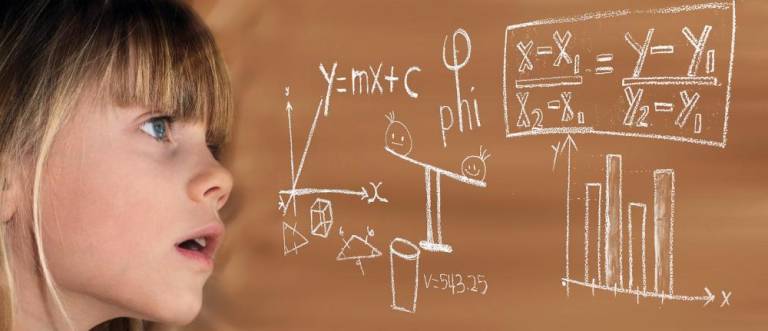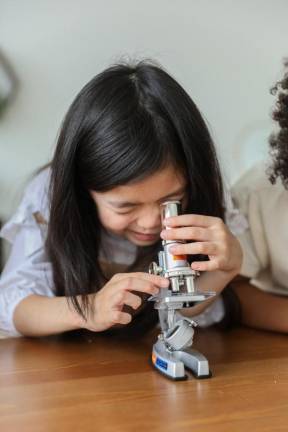Girls and science: A rising tide
The sciences. Educators are incorporating science, math and problem-solving at the earliest levels to encourage all students, especially girls, to seek a future in the sciences.



In the ever-changing world of education, school districts are increasing science education in the early grades to create an environment that encourages all students, especially girls, to seek a future in the sciences.
“We have found that girls’ interest in science is largely shaped by the environment around them,” said David Jacob, regional coordinator for science education at Putnam/Northern Westchester BOCES. “We have not always engaged girls in terms of focusing on careers in the sciences, but for the first time nearly every state in the union is making a concerted effort to involve all students in the sciences, which is really science and engineering.”
Jacob said that until the past decade or so, there was a lack of concern that the number of boys studying, majoring in and working in science badly outnumbered the number of girls doing the same. A 2010 report by American Academy of University Women (AAUW) found that while male and female students took roughly the same number of science classes in their elementary, middle and high school years, females were much less likely than males to major in science, technology, engineering or mathematics (STEM) in college.
The exact reasons why, according to the report, included the possibility of biological gender differences but also “evidence that social and environmental factors contribute to the underrepresentation of women in science and engineering.”
For this, experts looked to math proficiency among female students. Thirty years ago, there were 13 boys for every girl who scored above 700 on the SAT math exam at age 13.
As of 2010, according to AAUA, that ratio had shrunk to about 3 to 1. The increase in the number of girls identified as “mathematically gifted” stemmed largely from educators making a point of bringing the mathematics conversation to girls.
So, what can done?
So, if environmental factors contribute to a lack of interest in the sciences on the part of females once they get to choose their course load as college students, what can be done in their formative years to change that outcome?
Additional studies raising similar questions contributed to the creation of a national framework for K-12 science education by the National Academy of Sciences in Washington, D.C., in 2013.
“In the K-12 framework, there is a section on equity and it needs to begin early on,” said Jacob, himself a co-creator of Science 21, a program used by schools to guide science curriculum. “It is now understood that to capture the imaginations of all students, we need to reflect all our students in the materials they are looking at as soon as they start their schooling. That means highlighting and discussing female scientists, having female and minority students pictured in our teaching materials instead of just white boys and shaping the conversations around science in ways that appeal to a diverse group of kids.”
For girls, doing rather than being
To further illustrate how important it can be to frame the subject a certain way, a 2019 New York University study found that girls and boys, but especially girls, show different levels of interest in science depending on the approach educators use. For example, if a girl in elementary school is asked if she wants to be a scientist, her response may be less than enthusiastic.
However, if she is asked if she wants to do a science experiment, her response tends to be more enthusiastic.
None of this comes as a surprise to Matthew Kravatz, assistant superintendent for curriculum and instruction at Monroe-Woodbury School District in Central Valley, N.Y.
“While we do not teach science, or any other subject, with a specific gender or group of students in mind, we do use the Science 21 program to guide our science curriculum and that brings with it the environmental qualities that appeal to the broad spectrum of students,” Kravatz said.
The landscape of today’s science education
Another aspect in the landscape of today’s science education, Kravatz said, is the changing requirements from New York State, something Science 21 enables the district to comply with.
“Science 21 incorporates the latest state standards and requirements and the work these kids are tasked with is leaps and bounds ahead of where it was when I was in school,” Kravatz said. “The state now requires students to complete four investigations, or labs, leading up to both state assessment exams in grades 5 and 8. The investigations are hands on and test a multitude of skills that push kids to be analytical and critical thinkers as opposed to mainly memorization.”
A flight and space module or a medical detective module
At Goshen School District in Goshen, N.Y., educators have students working together to solve science-based questions before they leave kindergarten.
“We introduced Project Lead the Way in 2019 from kindergarten to grade 8,” said Goshen Assistant Superintendent for Curriculum, Instruction, Personnel and Technology Jason Carter. “What this has done is move us more into activity and project-based learning, which begins with open-ended questions that allow students of all ages to focus on and solve a real-life problem. It may be a flight and space module, a robotics and automation module or a medical detective module, but they are presented with a unique question and by working collaboratively in small groups they come up with a solution which brings with it their unique perspectives. This is hands on, experiential learning that allows students to study different career paths at a young age before they even realize it.”
Most districts, including Monroe-Woodbury and Goshen, are using an integrated approach when it comes to science, explained Warwick, N.Y.-based Warwick Valley Schools Assistant Superintendent for Curriculum and Instruction Megan McGourty.
“We take an integrated approach to science instruction, especially at the elementary school level,” McGourty said. “Literacy instruction is the biggest driver for our younger students, so by weaving in science concepts and content through literacy instruction all of our students develop an understanding of scientific concepts as well as literacy development, communication skills and language development.”
In Vernon, kids incorporate science in their play
In addition to using an integrated approach, educators at Vernon Township School District in New Jersey start science education before kindergarten to get kids to incorporate the topic in their play.
“Our Pre-K uses Tools of the Mind and that is a program that gets the little ones play acting as scientists and doctors to get them thinking in terms of asking questions and incorporating the subject matter into their play,” explained Dr. Hollyce Schoepp, Vernon Township’s K-12 supervisor of STEM education. “It is important that our preschools and elementary schools introduce these concepts so that kids incorporate them into their play before the concepts seem too challenging. This will encourage all students, regardless of gender or race, to be more open to the sciences as they get older.”
“It is now understood that to capture the imaginations of all students, we need to reflect all our students in the materials they are looking at as soon as they start their schooling. That means highlighting and discussing female scientists, having female and minority students pictured in our teaching materials instead of just white boys and shaping the conversations around science in ways that appeal to a diverse group of kids.”
- David Jacob, regional coordinator for science education at Putnam/Northern Westchester BOCES